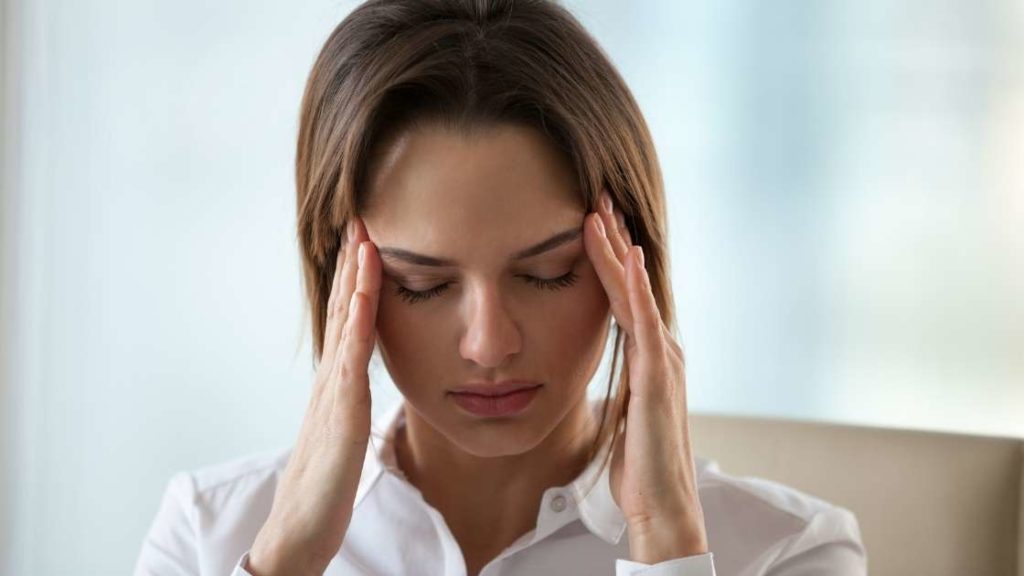Massage for Migraines

Of all the many kinds of abhorrent headaches, the migraine is the most sinister. They can make a gleam of light seem blinding, and the slightest noise sound explosive.
While there are many ways to treat migraines, massage is one of the more natural and safe alternatives. But what is the best massage for a migraine? Really, it depends on the patient. Migraines vary in intensity, frequency, and symptoms. So the ideal massage has to meet the unique needs of each person.
Before we dig into the massage modalities, let’s do a quick overview of migraine headaches and how terrible they are.
Overview of the Migraine
A migraine is a neurological condition caused by a dysfunction in the sympathetic nervous system (SNS). Your SNS is responsible for the fight-or-flight response, and it prompts the body to react quickly when it senses danger. With migraines, this system can fire even when no threat is present.
When fight-or-flight takes place, the brain releases norepinephrine and adrenaline. These chemicals increase blood pressure, heart rate, breathing rate, muscle tension, and then leave the body in an exhausted state once the threat is gone. Throbbing headaches tend to follow the exhaustion phase.
Aside from strong headaches, migraines can also be accompanied by:
- Dull or throbbing pain in the face and/or neck
- Sensitivity to light and sound
- Distorted vision
- Dizziness or lightheadedness
- Nausea
- Irritability
- Nasal congestion
- Fatigue
- Emotional stress
With the cause and symptoms in mind, let’s discuss how massage meets the needs of migraine headaches.
What Is The Best Massage for Migraines?
Swedish Massage for Migraines
Note the last symptom I listed above. Emotional stress will turn a migraine attack into a repetitive loop. The malfunctioning SNS leads to a migraine, and then the stress caused by the migraine will cause the SNS to activate again. For this reason, people who suffer from anxiety, as well as migraines, may have them more frequently.
The main benefit of Swedish massage is emotional relaxation. It lowers heart rate, improves circulation, and slows respiration; reversing the responses of a firing SNS. The gliding and kneading of a Swedish massage reactivate the parasympathetic nervous system (PNS), which is known as the rest-and-digest system. When the PNS suppresses the SNS, the muscles relax and the pain lessens. Any patient enduring migraines can benefit from a relaxation massage, and those with anxiety may want to get them more frequently. A gentle scalp massage can be soothing too unless the scalp is too tender.
Deep Tissue Massage for Migraines
While deep tissue massage may not be ideal during a migraine, it can be very helpful in between migraine attacks. When experiencing a migraine, senses are heightened and strong pressure could just add more pain.
After a migraine subsides, your muscles are tense from the general discomfort experienced. The muscles at the base of your skull, the suboccipitals, may especially need attention. A blockage in the greater occipital nerve, a sensory nerve involved in pain syndromes, can often be linked to migraines.
Deep tissue will break up the adhesed muscle tissue brought on by the migraine’s symptoms, and digging into the base of the skull can release the suboccipital tension.
Lymphatic Drainage for Migraines
This type of massage is ideal for a migraine accompanied by nasal congestion and swelling. A lymphatic drainage massage for migraines will focus on the scalp, face, and/or neck. Light strokes will be directed towards the submandibular lymph nodes, which are located beneath the lateral angles of the jaw. The lymph will carry the congestion causing toxins to the nodes where they can be neutralized. Once the wastes are cleansed from the area, migraine-induced congestion will reduce.
Acupressure for Migraines
While acupressure isn’t really a massage modality, it is often added to massage; usually deep tissue, since it can be a little intense.
The tips of the toes are correlated with the cranium, and a pinch to the area between the hallux (big toe) and second toe can be used for migraine relief. On the hand, the area between the base of the thumb and index finger can also be used.
Symptoms other than throbbing headaches can also be treated with acupressure. The area where the top of the ear meets the temple is associated with jaw and facial pain, and the area between the eyebrows (third eye) can offer stress relief.
What Is The Best Massage for Your Migraine?
Do you have an idea of how often your migraines arise? Do you think you’d benefit from a massage during the migraine or after it subsides? What symptoms do you generally experience? These are all questions to ask yourself before booking a massage for migraine treatment.
Stay happy, healthy, and pain-free!

Katrina Jenkins
Author, Licensed Massage Therapist
Katrina Jenkins graduated from Towson University in 2013 with a Bachelor’s Degree in Health Science and worked as a nurse’s aide briefly before pursuing her true passion. She graduated from the Massage Therapy Institute of Colorado in April 2016 with honors and completed the Touch of Healers Scholarship Program the following summer. She has been a part of the Moyer Total Wellness Team since the summer of 2017.
Resources
“Acupressure for Pain and Headaches.” Memorial Sloan Kettering Cancer Center, 24 Oct. 2019, www.mskcc.org/cancer-care/patient-education/acupressure-pain-and-headaches.
Miles, Otesa. “Migraine Triggers: Emotions and Stress.” Migraine.com, Nov. 2010, migraine.com/migraine-triggers/emotions-stress/#:~:text=When%20the%20brain%20senses%20stress,when%20you%20have%20a%20migraine.
“Occipital Neuralgia.” Johns Hopkins Medicine, www.hopkinsmedicine.org/health/conditions-and-diseases/occipital-neuralgia.
Trettin, H. “Manual Lymph Drainage in Migraine Treatment–a Pathophysiologic Explanatory Model.” Zeitschrift Fur Lymphologie. Journal of Lymphology, U.S. National Library of Medicine, July 1989, pubmed.ncbi.nlm.nih.gov/2672665/.
Photo Credit
Canva by fizkes from Getty Images Pro
